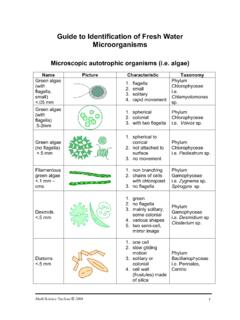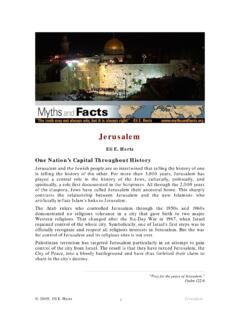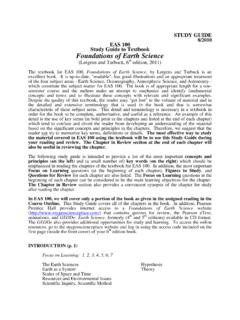Transcription of IGNEOUS ROCKS - msnucleus.org
1 Math/Science Nucleus 20011 IGNEOUS ROCKST eacher Guideincluding Lesson Plans, Student Readers, and More InformationLesson 1 - Rock CycleLesson 2 - Formation of IGNEOUS RocksLesson 3 - Classification of IGNEOUS RocksLesson 4 - IGNEOUS ROCKS - LabLesson 5 - Formation of Granitedesigned to be used as an Electronic Textbook in class or at homematerials can be obtained from the Math/Science Nucleus Math/Science Nucleus 20012 Objective: Students explore details ofthe rock cycle. Teacher noteThe rock cycle is a journey of how three types of ROCKS recycle themselvesthroughout Earth s history .
2 Review with students the three types including IGNEOUS ,metamorphic, and sedimentary. Discuss in detail the rock cycle using the graphicsin the reader . As students go through each of these lessons, emphasize how it fitsinto the rock are several web sites that can assist you in learning more about thedifferent components of the rock cycle. Below are just a few, but we suggest you doa search to find any new or updated sites on the Rock Cycle. The Stupid Page of ROCKS - good basic information on ROCKS , aimed at California State University, Long Beach, tour of IGNEOUS James Madison University Geology DepartmentEARTH SCIENCES - IGNEOUS ROCKSL esson 1 - Rock Cycle MATERIALS: reader Math/Science Nucleus 20013 Looking in the caldera of Mt.
3 EtnaWalking on the top of Mt. EtnaThe eruption occurred only a few months ago, but yetthe tour buses are bringing people to view the majestic , on the island of Sicily. The view from the window isobscured by ash that still rains down as the wind kicks ash andspins it around the bus. The tires on the bus are speciallymade to drive over the crumbly, jagged basaltic rock. Thecreation of IGNEOUS ROCKS is an awesome sight, especially whenyou realize that this is the beginning of the rock snow combines with the ash to make a grayslush that seems out of place,on a mountain where lavarecently rolled down theflanks of the volcano.
4 Thebus can only go so far,because another lava flowcould erupt at any time. Asyou walk to the caldera, youwonder about what you willsee. Weird thoughts of seeing the center of the Earth oreven jumping to join the devil, enter your thoughts. As you look over, the gas looks like it is bubbling,like a witch s brew. The wind from the earthly hole whipsyour hat, as you jump back and almost wish you hadn twanted to experience the formation of IGNEOUS isn t easy for ROCKS . They areborn from breaking, melting, and extremepressures.
5 ROCKS never die. They areforever forming and changing. We standon ROCKS , build with ROCKS , grow food fromrocks, and mine resources from ROCKS . Look around and you can see thatthe products of minerals and ROCKS are avital part of our everyday life. Concrete is abuilding material made of cement (calciteand clay), sand, and gravel. Cinder blocksare reformed cinder deposits from avolcano. Homes use a variety of stonesas building and ornamental materials. The rock cycle is a symbol of an ever-changing Earth.
6 The three types of rocksigneous, metamorphic, and sedimentary, record these changes, and it is up togeologists to decipher the clues and develop a history of the Earth. Math/Science Nucleus 20014 Lava flow from HawaiiKenya, AfricaSimplified rock cycleEarly humans could not imagine whererocks came from. They could describe thephysical features of a rock but it was difficult todetermine where ROCKS came from. ROCKS thatformed through the action of water were observedearly on.
7 Since sedimentary ROCKS are the mostcommon on the surface of the Earth, it was easyfor people to make this connection. Geologists even up to the early 1800'sbelieved that all ROCKS crystallized from oceanicwater. Even volcanic eruptions were thought tobe burning ofcoal seams beneath a volcanic vent. Eventually the Neptunists or people who believed that all rockscame from water, were replaced by geologists whowitnessed volcanic activity. An expedition around1730's to Iceland, watched lava flows from fissures inthe Earth, was the evidence that Plutonists (scientistswho believed that volcanic ROCKS were from within theEarth) needed to dispel the theories of the was not until the 1960's that theunderstanding of the crust of the Earth, through platetectonic movement, did it become apparent how therocks actually recycled themselves.
8 Slowly throughtime, the crust of the Earth moves and causes ROCKS tomelt, crystallize, weather, and get squished over andover through time. The understanding of platetectonics gave geologists anoverall picture of we are stillrefining how ROCKS areformed. Even some rockslike granite ( IGNEOUS ) andchert (sedimentary) are stillin debate. As we understandmore of the dynamics of thecrust and its interaction withthe mantle and core, we might unlock the mysteries of how rocksare formed.
9 Math/Science Nucleus 20015 Metamorphic ROCKS from Canadian shieldSedimentary ROCKS from Canyon de Chelly, ArizoniaAs we understand them now, IGNEOUS ROCKS are formed when ROCKS are melted andthen cooled. Magma can cool slowly inside the crust and upper mantle of the Earth, formingrocks like granite. Granite has large minerals that can be seen with the naked eye. Theseare called plutonic ROCKS . Quick cooling magmas are generally erupted onto the Earth ssurface, called volcanic ROCKS . IGNEOUS rocksare found where platesdiverge, as lava risesand fills the gapbetween the ROCKS also formwhere plates subducting platemelts as it sinks into thecrust of the Earth, andthe melt rises into theoverriding plate ROCKS are formed mainly in thelithosphere or crust and upper mantle, wherever there is highpressure and high temperature.
10 If the pressure andtemperature are too high,metamorphic rock will melt andbecome IGNEOUS . Metamorphic rocksare most abundant at convergentplate boundaries, but can occur inother areas where there are increasedpressures and/or ROCKS form onlyon the surface of the ROCKS form in two mainways, from clastic material (pieces ofother ROCKS or fragments of skeletons)that are cemented together, and by chemical mechanismsincluding precipitation and evaporation.










